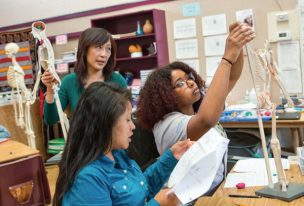
What Happens in a Lead by Learning Design Team Meeting?
For every partnership, Lead by Learning holds monthly design team meetings. In these meetings, Lead by Learning facilitates a conversation that invites educators to engage in design thinking to deepen adult learning in their system.
Design Team meetings include educators representing a vertical slice of their system. For example, for school site partnerships, design team meetings include teachers, principals, assistant principals, and sometimes coaches. For our district partnerships, design teams consist of principals, district leaders, and other educators.
Rather than asking these educators to leave their roles at the door, Lead by Learning invites them to bring into the space the important assets and unique perspective that come with their role–their expertise, their vantage point, the tensions they navigate, the priorities that emerge, the data they encounter–so that collectively they hold a whole-systems perspective to problem solving and continuous improvement.
Facilitating authentic meaning-making that transcends positionality takes time and attention. Lead by Learning intentionally develops relational trust, aligns educators’ values and purpose, adapts facilitation to leverage impromptu sense-making opportunities that emerge in real time, and provides consistent synthesis and knowledge management so that the ideas generated in the design team meetings are integrated into adult learning spaces.
At a design meeting, Lead by Learning facilitates a space where educators can practice the following.
- Peeling back thinking to expose mental models: With the support of a Lead by Learning facilitator, Design Team members are asked to dig into the questions, reactions, and wonderings that emerge during their conversation to explore the mental models that might be influencing their thinking and decision-making.
- Pushing thinking by speaking one’s truth and providing an alternate perspective: In order to broaden one’s understanding of root causes, design team meetings ask members to share personal experiences and listen to their colleagues’ experiences across different layers of their system.
- Deep listening without having to facilitate or stick to an agenda: Rather than spending their cognitive load on facilitation, every member is asked to focus their attention on deeply listening to one another.
- Sharing half-baked ideas to iterate and innovate: Conditions are created for educators to “embrace confusion as a creative space for emergence” as Monica Sharma writes in Radical Transformational Leadership.
- Holding complex needs at the same time: When we break down silos in a system, we are able to see the convergence of needs and weave them together into action.
- Empowering learners to be changemakers: Design Teams distribute leadership and reposition every educator to be active participants in systems.
At a recent Design Team meeting, a district leader said, “I’ve noticed principals are creating action steps that don’t align with their site goals.”
A principal responded, “Action steps aren’t my problem. What I struggle with the most is identifying data. It’s hard to figure out what data the district wants us to look at. Without data, it’s challenging to name action steps.”
In these comments, mental models were revealed around feelings of compliance and misalignment of root causes.
The district leader replied, “I wish I knew how to articulate that the district genuinely wants sites to name their own data sources. There isn’t a secret district agenda around data. However, this is making me think that we need to give principals permission to name their own data sources. We also need to highlight how much the district values formative assessments.”
The principal nodded and said, “Yes, that permission and clarification would be very helpful.”
In this short exchange, the design team was able to hold multiple perspectives in the system and use them to identify a path forward together. The district leader and the principal were able to share their truths as equal participants and their different perspectives enabled the group to design their upcoming session with both individual and systemic needs in mind.
Moments like these not only support Lead by Learning to design adult learning sessions that feel meaningful, relevant, and learner-centered, they also support Lead by Learning partners to deepen distributive leadership in their system by creating a culture of gratitude and reciprocity. In Braiding Sweetgrass, Robin Wall Kimmerer writes that “It’s such a simple thing but we all know the power of gratitude to incite a cycle of reciprocity.” When educators appreciate one another’s perspectives and they see how their collective perspectives lead to action, they feel empowered to spread it across their system.
Partner with Lead by Learning and experience Design Team meetings to support your system’s goals for students.
Download our Design Team tool today to get started with this practice.

